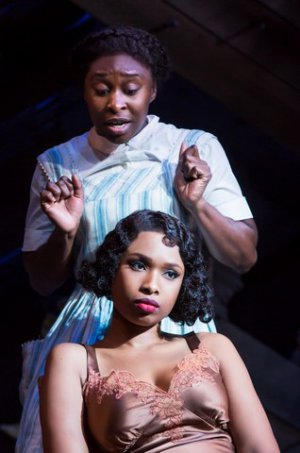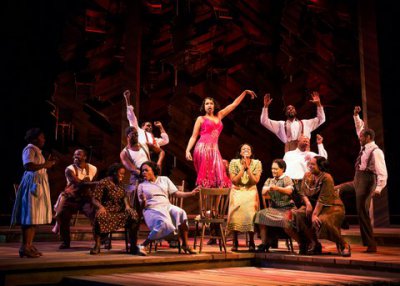The Color Purple
Powerful performances and imaginative staging make this stripped down revival of the musical based on the inspirational novel a magnificent experience.

Cynthia Erivo and Jennifer Hudson (seated) in a scene from “The Color Purple” (Photo credit: Matthew Murphy)
[avatar user=”Darryl Reilly” size=”96″ align=”left” ] Darryl Reilly, Critic[/avatar]John Doyle’s imaginative direction, the powerful performances of Cynthia Erivo, Jennifer Hudson and Danielle Brooks in their sensational Broadway debuts and a dynamic ensemble all make this stripped-down revival of The Color Purple a magnificent experience.
In addition to his remarkable staging that is highly visual and elicits passionate performances from the cast, Mr. Doyle also designed the dazzling set. It’s a basic rustic amalgam of three thin wooden columns and an enveloping piecemeal wall of wooden slats hung with chairs. Combined with minimal props and the many chairs that are often utilized, it’s all an ingenious canvas to present pared-down theatrical storytelling.
Alice Walker’s novel The Color Purple was published in 1983, has since sold over 10 million copies and went on to win The Pulitzer Prize for Fiction. Set in Georgia and parts of the South and spanning 1909 to 1949, it chronicles the life of the 14-year African-American old Celie when we first meet her. She is subject to abuse by her widowed father and her sister Nettie who runs away to escape this treatment. Celie is married off to the equally abusive Mister. Living on his farm, she becomes friends with his good-natured son Harpo’s domineering wife Sofia. She also becomes close to Shug Avery, a singer and Mister’s on and off again mistress. Many brutal, poignant and dramatic events are depicted.
The 1985 film adaptation directed by Steven Spielberg was a major success and launched the careers of Whoopi Goldberg as Celie and Oprah Winfrey as Sofia in their screen debuts. The this musical version originally opened on Broadway in 2005 and ran for over two years; LaChanze won Tony Award for Best Actress in a Musical as Celie.
Playwright Marsha Norman’s book brilliantly and very faithfully streamlines and extracts the events and themes of the novel and film. These include racism, sexism, self-esteem and same-sex attraction. In addition, Ms. Norman created the clever device of three gossiping church ladies who appear throughout and briskly impart exposition. Her work swiftly and skillfully renders this sprawling tale into a contained and emotionally involving narrative.
The tuneful score’s music and lyrics are the joint collaboration of Brenda Russell, Allee Willis and Stephen Pate Bray. It’s a variety of ballads, ensemble numbers and character songs in the styles of gospel, jazz, pop and Broadway. “I’m Here” is the proverbial 11 o’clock number for Celie that instigated a spontaneous standing ovation during Ms. Erivo’s performance of it at the performance attended.
Ms. Erivo is reprising this role from London’s 2013 Menier Chocolate Factory production that she appeared in and that was also directed by John Doyle. Wide-eyed, girlish and animated, Erivo is commanding. She radiantly conveys the inner joy and strength of the character that endures despite tremendous hardships as well as wonderfully singing with force and emotion.
Dreamgirls Oscar winner and American Idol star Jennifer Hudson is terrific as Shug Avery. Vocally she is flawless as expected but she is also is an excellent dramatic and comedic actress fiercely conveying the wily depth of this resourceful survivor.

Cynthia Erivo and Joaquina Kalukango in a scene from “The Color Purple” (Photo credit: Matthew Murphy)
Orange Is the New Black cast member Danielle Brooks as Sofia marvelously portrays this larger than life figure with mesmerizing bravado and pathos.
Isaiah Johnson though merciless as Mister adeptly shows this villain’s complexities. Kyle Scatliffe’s Harpo is a wonderful comic portrayal with range. As Celie’s sister Nettie, Joaquina Kalukango enchantingly portrays that role’s mystical qualities with touching reality. Kevyn Morrow is grandly chilling as Celie’s father. With steely tough love, philosophizing Lawrence Clayton makes a very fine impression as Mister’s tyrannical father. The rest of the company beautifully enacts the numerous other parts all with engaging flair.
Ann Hould-Ward’s rich costume designs are mainly a realistic collection of rural garments and vibrant nightclub gowns for Shug, as well as a colorful assortment of women’s trousers for a rousing production number. The lighting design by Jane Cox evocatively renders the passage of time, changing locales and boldly highlights the fluctuating moods. Gregory Clarke’s sound design vividly presents the shattering and eerie sense of life in The South and also the joyous interludes by modulating the music and interspersing sounds effects.
Besides directing and designing the show, John Doyle is also responsible for staging its musical numbers. Doyle’s work in this field adds to the stunning presentation. The company fills out the space precisely and gracefully with assured movement that yields many breathtaking stage pictures often involving chairs.
He is the Tony Award-winning British director notable for his often minimalist approach that has been seen on Broadway in such works as Sweeney Todd, Company and The Visit. His achievements here are unquestionably a high point of his already remarkable career.
This majestic production of The Color Purple gloriously proves that often in the theater less is more.
The Color Purple (through January 8, 2017)
Bernard B. Jacobs Theatre, 242 West 45th Street, in Manhattan
For tickets, call 800-432-7250 or visit http://www.colorpurple.com
Running time: two hours and 30 minutes with one intermission







Leave a comment